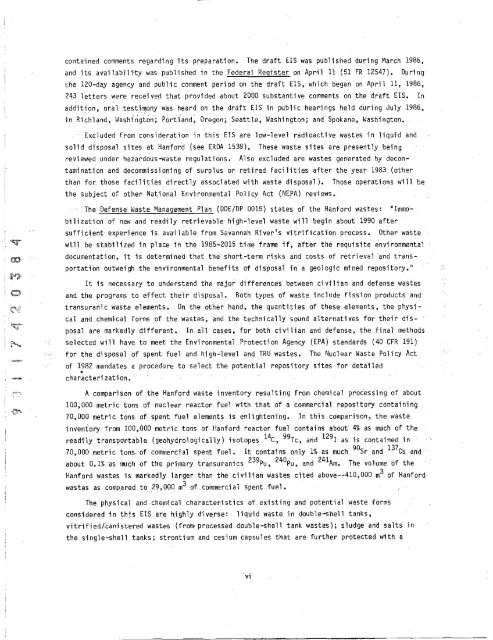EIS-0113_Section_9 - Hanford Site
EIS-0113_Section_9 - Hanford Site
EIS-0113_Section_9 - Hanford Site
You also want an ePaper? Increase the reach of your titles
YUMPU automatically turns print PDFs into web optimized ePapers that Google loves.
contained comments regarding its preparation. The draft <strong>EIS</strong> was published during March 1986,<br />
and its availability was published in the Federal Register on April 11 (51 FR 12547). During<br />
the 120-day agency and public comment period on the draft <strong>EIS</strong>, which began on April 11, 1986,<br />
243 letters were received that provided about 2000 substantive comments on the draft <strong>EIS</strong>. In<br />
addition, oral testimony was heard on the draft. <strong>EIS</strong> in public hearings held during July .1986.,<br />
in Richland, Washington; Portland, Oregon; Seattle, Washington; and Spokane, Washington. -<br />
Excluded from consideration in this <strong>EIS</strong> are low-level radioactive wastes in liquid and<br />
solid disposal sites at <strong>Hanford</strong> (see ERDA 1538). These waste sites are presently being<br />
reviewed under hazardous-waste regulations. Also excluded are wastes generated by decontamination<br />
and decommissioning of surplus or retired facilities after the year 1983 (other<br />
than for .those facilities directly associated with waste disposal). Those operations will be<br />
the subject of other National Envi-ronmental Policy Act (NEPA) reviews..<br />
The Defense Waste Management Plan (DOE/DP 0015) states of the <strong>Hanford</strong> wastes: "Immo -<br />
bilizationof new and readily retrievable high-level waste will begin about 1990 after<br />
sufficient experience is available from Savannah River's vitrification process. Other waste<br />
"'IIr will be stabilized in place in the 1985-2015 time frame if, after the requisite environmental<br />
documentation, it is determined that the short-term risks and costs of retrieval and transportation<br />
outweigh the environmental benefits of disposal in a geologic mined repository."<br />
It is necessary to understand the major differences between civilian and defense wastes<br />
and the prograRs to effect their disposal. Both types of waste include fission products and<br />
transuranic waste elements. On the other hand, the quantities of these elements, the physical<br />
and chemical forms of the wastes, and the technically sound alternatives for their disposal<br />
are markedly different. In all cases, for both civilian and defense, the final methods<br />
ICI _ selected will have to meet the Environmental Protection Agency (EPA)standards (40 CFR 191)<br />
for the disposal of spent fuel- and high-level and TRU wastes. The Nuclear Waste Policy Act<br />
of 1982 mandates a procedure to select the potential repository sites for detailed<br />
characterization.<br />
A comparison of the <strong>Hanford</strong> waste inventory resulting from chemical processing of about<br />
100,000 metric tons of nuclear reactor fuel with that of a commercial repository containing<br />
70,000 metric tons of spent fuel elements is enlightening. In this comparison, the waste<br />
inventory from 100,000 metric tons of <strong>Hanford</strong> reactor fuel contains about 4% as much of the<br />
readily transportable (geohydrologically)isotopes 14C, 99Tc', and 129 I°asis contained in<br />
70,000 metric tons of commercial spent fuel-. It contains only 1% as much 90Sr and ' 137 Cs and<br />
about 0.1%.as much of the primary transuranics 239pu., 240 Pu, and 241 Am. The volume of the<br />
<strong>Hanford</strong> wastes is markedly larger than the civilian wastes cited above--410,000 m 3 of <strong>Hanford</strong><br />
wastes as compared to 29,000 m 3 of commercial spent fuel.<br />
The physical and chemical characteristics of existing and potential waste forms<br />
considered in this <strong>EIS</strong> are highly diverse: liquid waste. in double-shell tanks,<br />
vitrified/canistered wastes (from processed double-shell tank wastes); sludge and salts in<br />
the single-shell tanks; strontium and cesium capsules that are further protected with a.<br />
vi

















